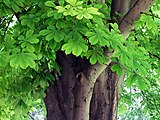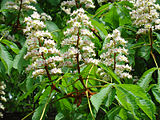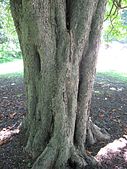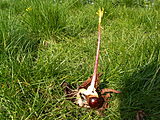Aesculus hippocastanum: Difference between revisions
m The section on medicinal uses had been flagged as lacking references. I added references supporting slightly modified medicinal uses. |
→Medicinal uses: Authors: Pittler MH, Ernst E |
||
| Line 49: | Line 49: | ||
===Medicinal uses=== |
===Medicinal uses=== |
||
The seed extract standardized to around 20 percent [[aescin]] (escin) is used for its venotonic effect, vascular protection, anti-inflammatory and free radical scavenging properties.<ref>Diehm C, Trampisch HJ, Lange S, Schmidt C. Comparison of leg compression stocking and oral horse-chestnut seed extract therapy in patients with chronic venous insufficiency. Lancet. 1996;347:292-4.</ref> <ref name = mskcc/> Primary indication is chronic venous insufficiency.<ref> |
The seed extract standardized to around 20 percent [[aescin]] (escin) is used for its venotonic effect, vascular protection, anti-inflammatory and free radical scavenging properties.<ref>Diehm C, Trampisch HJ, Lange S, Schmidt C. Comparison of leg compression stocking and oral horse-chestnut seed extract therapy in patients with chronic venous insufficiency. Lancet. 1996;347:292-4.</ref> <ref name = mskcc/> Primary indication is chronic venous insufficiency.<ref>http://nccam.nih.gov/health/horsechestnut NCCAM.nih.gov Horse Chestnut page </ref> <ref name = mskcc/>A recent [[Cochrane Review]] found the evidence suggests that Horse Chestnut Seed Extract is an efficacious and safe short-term treatment for [[chronic venous insufficiency]].<ref> Pittler MH, Ernst E., Cochrane Database Syst Rev. 2012;11:CD003230 </ref> |
||
Aescin reduces fluid leaks to surrounding tissue by reducing both the number and size of membrane pores in the veins.{{medcn|date=November 2012}} |
Aescin reduces fluid leaks to surrounding tissue by reducing both the number and size of membrane pores in the veins.{{medcn|date=November 2012}} |
||
Revision as of 14:43, 17 January 2013
| Aesculus hippocastanum | |
|---|---|

| |
| Aesculus hippocastanum, Horse-chestnut planted as a feature tree in a park | |
| Scientific classification | |
| Kingdom: | |
| (unranked): | |
| (unranked): | |
| (unranked): | |
| Order: | |
| Family: | |
| Genus: | |
| Species: | A. hippocastanum
|
| Binomial name | |
| Aesculus hippocastanum | |
Aesculus hippocastanum is a large deciduous tree, commonly known as horse-chestnut or conker tree.
Distribution
Aesculus hippocastanum is native to a small area in the Pindus Mountains mixed forests and Balkan mixed forests of South East Europe.[1] It is widely cultivated in streets and parks throughout the temperate world.
Growth
A. hippocastanum grows to 36 metres (118 ft) tall, with a domed crown of stout branches; on old trees the outer branches often pendulous with curled-up tips. The leaves are opposite and palmately compound, with 5–7 leaflets; each leaflet is 13–30 cm long, making the whole leaf up to 60 cm across, with a 7–20 cm petiole. The leaf scars left on twigs after the leaves have fallen have a distinctive horseshoe shape, complete with seven "nails". The flowers are usually white with a small red spot; they are produced in spring in erect panicles 10–30 cm tall with about 20–50 flowers on each panicle. Usually only 1–5 fruit develop on each panicle; the shell is a green, spiky capsule containing one (rarely two or three) nut-like seeds called conkers or horse-chestnuts. Each conker is 2–4 cm diameter, glossy nut-brown with a whitish scar at the base.[2]
Etymology
The common name "horse-chestnut" (often unhyphenated) is reported as having originated from the erroneous belief that the tree was a kind of chestnut (though in fact only distantly related), together with the observation that eating the fruit cured horses of chest complaints[3] despite this plant being poisonous to horses.
Uses
Cultivation for its spectacular spring flowers is successful in a wide range of temperate climatic conditions provided summers are not too hot, with trees being grown as far north as Edmonton, Alberta, Canada,[4] the Faroe Islands,[5] and Harstad, Norway.
This tree[6] and the red flowering cultivar A. hippocastanum 'Baumannii'[7] have gained the Royal Horticultural Society's Award of Garden Merit.
In Britain and Ireland, the nuts are used for the popular children's game conkers. During the two world wars, horse-chestnuts were used as a source of starch which in turn could be fermented via the Clostridium acetobutylicum method devised by Chaim Weizmann to produce acetone. This acetone was then used as a solvent which aided in the process of ballistite extrusion into cordite, which was then used in military armaments.

The nuts, especially those that are young and fresh, are slightly poisonous, containing alkaloid saponins and glucosides. Although not dangerous to touch, they cause sickness when eaten; consumed by horses, they can cause tremors and lack of coordination.[8] Some mammals, notably deer, are able to break down the toxins and eat them safely.[citation needed]
In the past, horse-chestnut seeds were used in France and Switzerland for whitening hemp, flax, silk and wool. They contain a soapy juice, fit for washing of linens and stuffs, for milling of caps and stockings, etc., and for fulling of cloth. For this, 20 horse-chestnut seeds were sufficient for six litres of water. They were peeled, then rasped or dried, and ground in a malt or other mill. The water must be soft, either rain or river water; hard well water will not work. The nuts are then steeped in cold water, which soon becomes frothy, as with soap, and then turns milky white. The liquid must be stirred well at first, and then, after standing to settle, strained or poured off clear. Linen washed in this liquid, and afterwards rinsed in clear running water, takes on an agreeable light sky-blue colour. It takes spots out of both linen and wool, and never damages or injures the cloth.
In Bavaria the chestnut[clarification needed] is the typical tree for a beer garden. Originally they were planted for their deep shade which meant that beer cellar owners could cut ice from local rivers and lakes in winter to cool the Märzen Lager beer well into summer. Nowadays guests enjoy the shade to keep their heads cool.
Horse-chestnuts have been threatened by the leaf-mining moth Cameraria ohridella, whose larvae feed on horse chestnut leaves. The moth was described from Macedonia where the species was discovered in 1984 but took 18 years to reach Britain.[9]
The flower is the symbol of the city of Kiev, capital of Ukraine.[10] Although the horse-chestnut is sometimes known as the buckeye, this name is generally reserved for the New World members of the Aesculus genus.
Medicinal uses
The seed extract standardized to around 20 percent aescin (escin) is used for its venotonic effect, vascular protection, anti-inflammatory and free radical scavenging properties.[11] [12] Primary indication is chronic venous insufficiency.[13] [12]A recent Cochrane Review found the evidence suggests that Horse Chestnut Seed Extract is an efficacious and safe short-term treatment for chronic venous insufficiency.[14]
Aescin reduces fluid leaks to surrounding tissue by reducing both the number and size of membrane pores in the veins.[medical citation needed]
Commonly used dose: Oral use, 250-300 mg extract standardized to around 20 percent aescin 1-3 times a day. Topical as a cream with 2% aescin.
Based on reports of worsening kidney function in people with kidney disease who received intravenous aescin, it is contraindicated in kidney and liver disease. Consistently very large oral doses should be avoided.
Raw Horse Chestnut seed, leaf, bark and flower are toxic due to the presence of esculin and should not be ingested. Horse chestnut seed is classified by the FDA as an unsafe herb.[12] The glycoside and saponin constituents are considered toxic.[12]
Aesculus hippocastanum is used in Bach flower remedies. When the buds are used it is referred to as "chestnut bud" and when the flowers are used it is referred to as "white chestnut".
Anne Frank Tree
A famous specimen of the horse-chestnut was the Anne Frank Tree in the centre of Amsterdam, which she mentioned in her diary and which survived until August 2010, when a heavy wind blew it over.[15][16]
Bonsai
The horse-chestnut is a favourite subject for bonsai.[17]
Diseases
- Bleeding Canker. Half of all horse-chestnuts in Great Britain are now showing symptoms to some degree of this potentially lethal bacterial infection.[18][19]
- Guignardia leaf blotch, caused by the fungus Guignardia aesculi
- Wood rotting fungi, e.g. such as Armillaria and Ganoderma
- Horse-chestnut scale, caused by the insect Pulvinaria regalis
- Horse-chestnut leaf miner, Cameraria ohridella, a leaf mining moth.[20] also affecting large numbers of UK trees.[21]
- Phytophthora bleeding canker, a fungal infection.[22]
Gallery
-
Leaves and trunk
-
Foliage and flowers
-
Close-up of flowers
-
Trunk
-
Germination on lawn
References
Notes
- ^ Euro+Med Plantbase Project: Aesculus hippocastanum
- ^ Rushforth, K. (1999). Trees of Britain and Europe. Collins ISBN 0-00-220013-9.
- ^ Lack, H. Walter. "The Discovery and Rediscovery of the Horse Chestnut" (PDF). Arnoldia. 61 (4).
- ^ Edmonton
- ^ Højgaard, A., Jóhansen, J., & Ødum, S. (1989). A century of tree planting on the Faroe Islands. Ann. Soc. Sci. Faeroensis Supplementum 14.
- ^ http://apps.rhs.org.uk/plantselector/plant?plantid=66
- ^ http://apps.rhs.org.uk/plantselector/plant?plantid=67
- ^ Lewis, Lon D. (1995). Feeding and care of the horse. Wiley-Blackwell. Retrieved 2011-10-21.
- ^ Lees, D.C.; Lopez-Vaamonde, C.; Augustin, S. 2009. Taxon page for Cameraria ohridella Deschka & Dimic 1986. In: EOLspecies, http://www.eol.org/pages/306084. First Created: 2009-06-22T13:47:37Z. Last Updated: 2009-08-10T12:57:23Z.
- ^ Kiev
- ^ Diehm C, Trampisch HJ, Lange S, Schmidt C. Comparison of leg compression stocking and oral horse-chestnut seed extract therapy in patients with chronic venous insufficiency. Lancet. 1996;347:292-4.
- ^ a b c d Horse Chestnut, Memorial Sloan-Kettering Cancer Center
- ^ http://nccam.nih.gov/health/horsechestnut NCCAM.nih.gov Horse Chestnut page
- ^ Pittler MH, Ernst E., Cochrane Database Syst Rev. 2012;11:CD003230
- ^ Sterling, Toby (24 August 2010). "Anne Frank's 'beautiful' tree felled by Amsterdam storm". The Scotsman. Retrieved 24 August 2010.
- ^ Gray-Block, Aaron (23 August 2010). "Anne Frank tree falls over in heavy wind, rain". Reuters. Archived from the original on 24 August 2010. Retrieved 24 August 2010.
{{cite news}}: Unknown parameter|deadurl=ignored (|url-status=suggested) (help) - ^ D'Cruz, Mark. "Ma-Ke Bonsai Care Guide for Aesculus hippocastanum". Ma-Ke Bonsai. Retrieved 2011-07-05.
- ^ "Extent of the bleeding canker of horse chestnut problem". UK Forestry Commission. Retrieved 2010-01-09.
- ^ http://www.suffolkcoastal.gov.uk/yourdistrict/trees/chestnuts/default.htm
- ^ "Other common pest and disease problems of horse chestnut". UK Forestry Commission. Retrieved 2010-01-09.
- ^ http://www.suffolkcoastal.gov.uk/yourdistrict/trees/chestnuts/default.htm
- ^
"[[Phytophthora Bleeding Canker of Horse Chestnut|Bleeding Canker]]". Royal Horticultural Society. 11 November 2009. Archived from the original on 16 January 2010. Retrieved 2010-01-09.
{{cite web}}: URL–wikilink conflict (help); Unknown parameter|deadurl=ignored (|url-status=suggested) (help)





